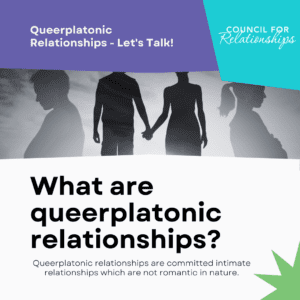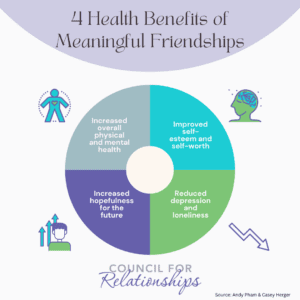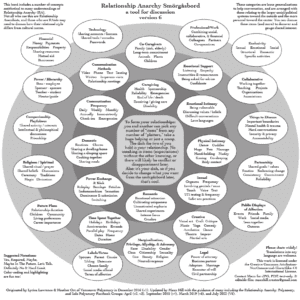Queerplatonic Relationships & Questioning Romantic Hierarchy
This blog discusses the overlapping of different types of relationships, particularly in queerplatonic bonds. It also explores the complexities of human connections.
Queerplatonic relationships go beyond labels and involve people who identify as asexual, aromantic, or sexual and romantic feelings. They show deep emotional intimacy. Queerplatonic partners display characteristics commonly linked to romantic partnerships, yet their bond defies easy categorization. Instead, their bond represents a unique blend of reliance, fondness, and commitment.
This blog studies how people in queerplatonic relationships manage their interactions. They form connections that respect their needs and limits. These bonds can be as deep, or even deeper, than romantic relationships. They make us think differently about love, commitment, and friendship, showing us the importance of emotional closeness.
Discover the intricate world of queerplatonic relationships. They may be a bit messy, but that’s perfectly fine.
What are queerplatonic relationships?
“It’s kinda messy… and that’s okay.”
We believe that queerness offers an abundance of relational wisdom for LGBTQ+ and heterosexual people alike. When we say “queerness” here, we are using it in the way that bell hooks (2014) defines it as “not who you’re having sex with . . . but queer as being about the self that is at odds with everything around it and that has to invent and create and find a place to speak and to thrive and to live”.
Queerness helps us understand relationships and love outside society’s norms. It expands our perspective and challenges the dominant straight, monogamous culture.
We might utilize queerness to think about the following three questions:
- How do we distinguish between “platonic” and “romantic” relationships?
- What kinds of closeness, intimacy, and love do we desire in our lives?
- How do we communicate these distinctions and desires to important others?
Have you heard any of these sentiments before?
“Guy friends don’t hug; that’s gay.”
“Men and women can’t be ‘just’ friends; sex will always be on the table.”
“Once she got a boyfriend, she hardly came to girls’ night.”
These are some examples of the scripts and norms that confine platonic intimacy. They might suggest that friends are placeholders for romantic partners and that only romance allows for physical intimacy.
Queer legacies make us question gender roles, compulsory sexuality, and capitalism’s impact on our relationships. Queerness asks us to consider whether these relational assumptions fulfill us and meet our needs.
What if we changed our understanding of love? How can we express love differently, and how might this change affect us, our relationships, and our communities?
What if we allowed ourselves to form and maintain relationships based on our own rules, not society’s rules?
What is the difference between “platonic” and “romantic” relationships?
In a culture that values heterosexuality and expects sex, the terms “platonic” and “romantic” have clear and contrasting meanings. The main difference between the two is whether those in the relationship wanted or had physical closeness.
Platonic relationships might be equally, if not more, emotionally intimate than their romantic counterparts. However, conventional platonic relationships might lack physical connection beyond hello and goodbye hugs.
The belief that physical closeness is inherently sexual distinguishes platonic from romantic relationships. Additionally, people consider this closeness more significant when it occurs between individuals of opposite genders.
Does holding hands or cuddling imply an escalation that leads to sex? What if we tell you that some cultures do not see a kiss as a sexual expression?
Queer people’s curiosity and defiance break down the strict divide between romantic and platonic relationships. Being queer allows us to express affection freely through actions such as holding hands and kissing. We don’t feel pressured to take it any further. Most importantly, queerness assures us that this can happen regardless of the gender labels of those involved.
Expanding Our Relational Language
While Valentine’s Day is a yearly holiday to celebrate romantic love, what holidays exist to celebrate nonromantic love? Many people have noticed this lack and adapted Valentine’s Day to meet their own needs.
Women gather to celebrate friendship on “Galentine’s Day,” and friends come together to celebrate “Palentine’s Day.” These Valentine’s Day adaptations honor friendship as something to celebrate openly with the community. These adaptations also demonstrate a desire for more rituals and more language to honor people’s relational experiences.
Rituals actually maintain close friendships. Using the attachment theory framework, Dr. Emily Langan from Wheaton College studies how to maintain emotionally close friendships.
Rituals are activities that we engage in as a group. Reassurances are gestures that demonstrate our desire for a future together. Openness refers to being honest during challenging moments in a relationship.
Dr. Langan’s research shows why humans need a large word bank to explain our relationships effectively. Much like “Galentine’s Day,” increasing our word bank allows us to build rituals together. This may also encourage us to consider other ways to build rituals, such as celebrating friendship anniversaries.
Using specific words helps us feel close and secure with our loved ones. We can use special language exclusively for them. This includes how some people distinguish between “acquaintances,” “friends,” and “best friends.”
It makes sense why people spend time thinking about how to honor their friendships and non-romantic relationships. Kiran S. K. Arora and Timothy R. Baima found that meaningful friendships provide the following four health benefits:
- Increased overall physical and mental health
- Improved self-esteem and self-worth
- Reduced depression and loneliness
- Increased hopefulness for the future
Historical Examples of Expansive Relational Language
People around us constantly find new and imaginative ways to build close relationships. We need to know where and how to look. Across human history, frameworks for love and relationships have constantly evolved to meet people’s unique contextual needs.
The ancient Greeks had eight types of love. These include eros (passionate or romantic love), philia (strong friendship love), and pragma (practical and dutiful love). Having larger word banks allowed people to more precisely define their relationships, for themselves and for third-party others.
In more recent history, LGBTQ+ Black and brown people practiced non-romantic intimacy through ball culture. During the 1970s, young queer individuals in the US had to leave their abusive and homophobic families. They formed supportive “houses” with house-parents and house-siblings.
Due to structural heterosexism and homophobia, the LGBTQ+ community may not always have access to conventional relationship structures like the nuclear family. There is still a need to have a sense of belonging, safety, and security in relationships, though, and using the vocabulary of family might be one way for people to communicate these essential human desires and bonds. This is how the concept of “chosen family” might emerge as a way to express the intimacy present in a nonfamilial bond.
When traditionally romantic relationships become out of reach to a community marginalized because of their relational desires, new relational frameworks and language emerge. The term “queerplatonic” emerges out of a similar necessity to describe a relational experience that falls outside the traditional platonic vs romantic dichotomy.
Relationship Anarchy, Queerplatonic Relationships, & Chosen Family
Relationship Anarchy, Queerplatonic Relationships, and Chosen Family are among the many relational frameworks people use to build fulfilling lives.
Many ask, “Can I be monogamous and have queerplatonic relationships?”
We suggest knowing the limits of your queerplatonic relationship and what you want from being “exclusive.”Monogamy requires us to establish (and reestablish) boundaries regarding emotional and physical closeness that we can experience with individuals other than our partner.
Different people may have different ideas about breaking monogamy. For example, one person may think that holding hands is acceptable, while their partner may not. Similarly, each individual in the relationship may see sharing nude photos or interacting on social media differently.
You can have a romantic or sexual partner and also have a queerplatonic relationship with someone else. This is possible as long as both parties agree on the level of emotional and physical closeness.
Relationship Anarchy is a philosophy of love rooted in the political philosophy of anarchism. Many people in nonmonogamous and polyamorous communities use this idea, but it’s open to anyone.
Like nonmonogamy, Relationship Anarchy challenges the idea that one should limit love and share it with only one person.
Relationship Anarchy suggests equal emotional connections with spouse/partner, loved ones, friends, community, and even pets. We can feel different levels of love or emotional closeness in different relationships. Relationship Anarchy does not automatically rank love based on someone’s title (like spouse, friend, sibling, etc.).
Relationship Anarchy framework challenges the idea that sex is the most important aspect of love in a relationship. If you were to ask 1,000 people, from children to adults, “What is love?” you’d get 1,000 different answers. Relationship Anarchy proposes that we expect and find love’s diversity beautiful. Relationship Anarchy and queerness advocate for creating our own labels when the given ones are too limiting.
May we always be able to shape and create our own ideas of love and relationships, just like the ancient Greeks, queer youth of color, and women who celebrate Galentine’s Day.
Ideas for Practice – Lessons from Queerplatonic History
How can we apply these concepts in our relationships after exploring the history, ideas, and frameworks for nonromantic intimacies?
We can learn from Dr. Langan’s research and see how we keep rituals, reassurance, and openness in our important relationships. You might ask yourself the following questions:
- Are there ways that you regularly celebrate this relationship?
- How do you directly and indirectly communicate the desire to be in each other’s future?
- How do you maintain transparency and compassion during a period of relational stretching?
We might also utilize the framework of Relationship Anarchy to clarify our relational needs. Consider the following questions:
- What do we need in our relationships to feel secure intimacy, and where do these things currently happen?
- Do old definitions of “romantic” and “platonic” limit us from asking for what we want in relationships?
- How might limiting hierarchies cause us to devalue friendships and overvalue romance?
Another way is to normalize “defining the relationship” (DTR) and relationship check-ins within our nonromantic relationships. One helpful tool for this is the Relationship Anarchy Smörgåsbord. This tool helps us figure out what we want in our relationship and communicate it to our partner.
This tool can help someone express their preference for daily texting. It can also assist someone in expressing their preference for practicing a religion alone rather than with others.
Continuing to Question
You can not define “queerness.” As such, as a framework, it refuses the rigidity of labels like “platonic” and “romantic” as exclusive opposites. Instead, queerness encourages us all to find the in-between and give it a new name. In this expansion, we find ourselves and each other.
Continue questioning how dominant scripts impact you and how you relate to others. Find the in-between, call it something else, something made up, and maybe even a little messy.
About the Authors
Andy Phạm (they/them) and Casey Herger (they/he) are both Council for Relationships Clinical Interns in CFR’s Marriage & Family Therapy Master’s Program.
Andy is a beginning systemic therapist currently thinking about strengths-based approaches, vicarious resilience, and the mental health impacts of colonialism. Andy has backgrounds in event programming for marginalized communities, social justice education workshops, and non-profit health equity work.
Casey is a budding MFT who is excited to bring intersectional and systemic thinking to the mental health field. Casey identifies as white-Latine, Queer, Non-Monogamous, and an Abolitionist. They enjoy reading in the park, going to Queer events in the city, and advocating for 3rd spaces.
If you have questions about this blog on queerplatonic relationships, please get in touch with Andy at apham@councilforrelationships.org or Casey at cherger@councilforrelationships.org
Click here to learn more about CFR’s Master’s Degree Program in Marriage & Family Therapy. If you have questions about this program, contact Allen-Michael Lewis at alewis@councilforrelationships.org.
Find a therapist or psychiatrist near you and schedule an appointment through our directory.
More from CFR
Our expert therapists, psychologists, and psychiatrists offer so much more to explore! Check out the CFR Expert Voices blog for great mental and emotional health advice and insight. Here are a few recent blogs we think you will enjoy. To get first access to our Expert Voices blog, join our mailing list!





